Kent
1 kW
Kindly borrowed from Mother Earth News:
Build a Bicycle Cargo Trailer
10/23/2012 5:08:07 PM
By Doug Costlow
Tags: bicycle cargo trailer
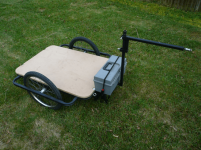
Have you ever wanted to take something extra with you when you ride your bike, but didn't know how you could get it on the bike and still be able to ride? I have, and believe me one of my favorite challenges about bike riding is figuring out how to strap anything from a tennis racket to a load of firewood to a bike. There is something about that moment when you wrap that bungee cord around your item just right, pull on it until your fingers hurt, and get it to hook on. You step back and think to yourself, "This is rigged but it just might stay on."
In my effort to carry more things with my bike, I decided to build a cargo trailer. It wasn't going to be a typical trailer, though. I wanted something that was heavy-duty, maybe something that could handle most household appliances. I got started just like with every other good homemade bicycle cargo trailer—with a pair of garbage-picked wheels and a set of tires that were given to me for free.
Here is a quick rundown of the main features of the cargo bike trailer:
•Large 28-by-41-inch deck
•Mounts to any bike rack with a quick-release ball joint
•1-inch square steel tube frame can accommodate up to 700-centimeter/29-inch wheels and tires
•100-millimeter dropout spacing to allow for most bicycle front wheels
•Space for toolbox with tools, straps, and bungee cords
•Adjustable pulling arm to allow mounting to any bike
My main motivation for building this DIY cargo bike came from many bike-move videos and blog posts on this topic. A bike move is just what it sounds like—moving to a new house using only bikes for transportation and hauling. This requires cargo bikes, bike trailers and the blank stares of people as you ride past with a massive load of stuff on your bike.
You're probably wondering, "How much can I really tow with a bike?" Well, the company Bikes At Work sells bicycle cargo trailers and has some great references on hauling large items by bike. Check out How Much Weight Can a Bicycle Carry? for a calculator on towing weight. It states that "Most people can comfortably pull 300 pounds (137 kilograms) with a typical mountain bike and cargo trailer." I have not purchased anything from this company but, from the info they give and the pictures of their trailers in action, I believe they sell a good product, although a little pricey.
So, now that you see the potential behind a simple DIY cargo bike trailer, let's build one!
NOTE: To use this bicycle cargo trailer you must have a bike rack.
Step 1: Assemble the Tools, Materials and Plans
Here is a list of the tools and materials you will need to build this bicycle cargo trailer.
Tools
A. 4.5-inch angle grinder with cutoff, grinding and sanding discs
B. Drill press with vice or c-clamp (not absolutely needed but makes drilling steel much easier)
C. Drill bits, sizes 1/4-inch, 5/16-inch and 3/8-inch
D. 3/8-inch No. 16 tap
E. Center punch
F. Hammer
G. Welder (I am currently using the 90-amp flux core welder)
H. Welding gloves and helmet
I. Tape measure
J. Permanent marker
Materials
A. 1-inch square tube steel (I got most of the steel for this trailer from an old BBQ grill and a bench-press stand)
B. 2-by-3/16-inch steel flat bar, 1 foot long
C. 1-by-3/16-inch steel flat bar, 1 foot long
D. 3/8-inch No. 24 threaded bolt rod, 1 1/2-inch long (fine thread size; could come from an old bike axle or you can just cut off the head of a right-sized bolt)
E. Two 3/8-inch No. 24 nuts (might also be able to use bike axle nuts)
F. Four 1/4-inch No. 20 2-inch long bolts with nuts and washers
G. Two 3/8-inch No. 16 1.5" long bolts with nuts and washers
H. Four 5/16-inch No. 18 eye bolts with nuts and washers
I. 28-by-41-inch piece of 3/4-inch MDF (for the deck of the trailer; you can use whatever material you want)
J. Quick disconnect ball linkage (McMaster part No. 6058K34)
K. Two bike wheels and tires (I used 20-inch wheels, but the frame design allows for larger 700-centimeter wheels)
Aside from the quick disconnect linkage, all items can be found at a local hardware store or picked from old bike parts. If you're going to purchase the steel, I would highly recommend finding a local steel supplier by searching the Yellow Pages. If that's not an option for you, I would recommend http://www.SpeedyMetals.com for fair prices and reasonable shipping.
If you're lacking some of the tools I mentioned, borrow them from an uncle, check out yard sales or search http://www.CraigsList.org. These tools are pretty common and should be easy to find at low cost. For the welder, a MIG or wire welder is best for this project. It is completely doable with a stick or even a TIG welder, so just use what you have. If you have never welded before, the 90-amp flux core welder I'm using is enough to learn with, and at roughly $100 it's by far the best bang for your buck.
Open my Trailer Drawings PDF to view detailed drawings of the frame and the pulling arm, both of which are explained in the next few steps.
Step 2: Make the Dropouts
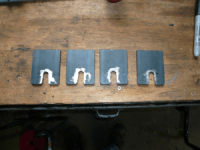
The dropouts are easy to make from 2-by-3/16-inch flat bar. First, put a cutoff wheel on your angle grinder. Cutoff wheels for this type of grinder are roughly 1/8-inch thick. If the wheel you have is thicker than that, it's not a cutoff wheel but a grinding wheel. Now put on your safety glasses; this is a must because your grinder will be throwing sparks everywhere. Mark off a 3-inch section of the bar and cut it off. I found that a good practice for cutting with a grinder like this is to first make a shallow cut right along your line. This will act as a guide when you make the rest of the cut. Repeat three more times to get four 3-inch long pieces.
Now get out the ruler and permanent marker and mark a point in the middle of each piece 3/4-inch from the end. Then grab your hammer and center punch, put the punch on your mark and hit it with the hammer. Don't miss! Next put one of the pieces in your vice and center up the center-punch mark with the drill bit in your drill press. Clamp everything down tight and put a dab of motor oil on the drill bit. This is not the ideal coolant method, but it will keep your bit from going dull. Set your drill press to the lowest speed possible, less than 500 rpm if you can. Then drill the hole and repeat for the next three parts.
Next, make a few marks from the edges of each hole to the edge of the part. Then get out your grinder and cut from the hole to the edge of the plate. When you're finished with all four dropouts, you'll be a cutoff wheel master and ready to tackle the rest of the project.
Step 3: Weld the Frame
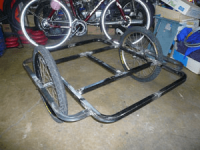
The frame is built from 1-by-1-inch square steel tubing. I recycled this material from an old BBQ grill and a bench press stand. The tubing already had the nice right-angle curved bends so all I had to do was cut and weld it together. The main box of the frame came from the legs of the bench press, which were butt-welded together. The two outer parts of the frame came from the BBQ grill and were also butt-welded together. The interior parts of the frame were straight sections of tubing and were welded in after finishing the perimeter of the frame.
If you don't have the luxury of steel tubing lying around, you can buy tubing from a local steel supplier. You don't need bends at the corners but they do make the trailer look nice. If you have straight tubing, you could bend it yourself with a Woodward Fab Pipe/Tube Bender.
Step 4: Fabricate the Pulling Arm
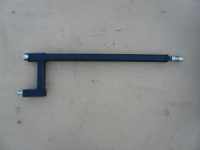
The pulling arm attaches the trailer to your bicycle rack. The arm is made from 1-by-1-inch steel tubing and 1-by-3/16-inch steel flat bar. The pulling arm attaches to the upright tube on the frame with two pinch bolts. The top pinch bolt goes through the two clamping plates with the 3/8-inch holes and around the upright tube. This clamps firming on to the upright tube. The bottom pinch bolt tightens against the upright tube and uses the tapped hole. This keeps the arm from twisting on the upright tube. I chose to attach the pulling arm in this way because I wanted to be able to adjust the height of the arm in order to keep the trailer platform level. By moving the arm up and down, I can adjust for different bike rack heights, so the trailer can always be level on any bike it's attached to.
Step 5: Build the Trailer Platform
I choose to use medium-density fiberboard (MDF) for the platform of the trailer, but realize now that it might not have been the best choice. A treated plywood may be better because it can get wet and not fall apart like MDF. You can use whatever sheet material you have, but something as rigid as 3/4-inch MDF or plywood is preferable. Making this platform is pretty simple. The dimensions are 28-by-41 inches. I cut a piece using a circular saw, then I clamped it to the trailer and marked the radius of the corners and cut those out with a jigsaw. I clamped it again to the frame and marked the locations of the mounting holes in the frame. I drilled the holes with a 1/4-inch bit, for the 1/4-inch bolts I called for in the parts list. I also wanted to make sure the platform was not obstructed by the heads of the bolts, so I marked out a section around the holes and used my router to cut out a pocket.
Step 6: Prepare Your Bike Rack
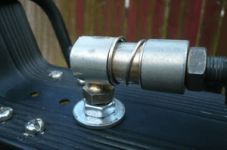
You need a rack to mount and pull this bicycle cargo trailer. The frame design and pulling arm are centered around this type of setup. The trailer is connected to the bike rack with a quick disconnect ball linkage (McMaster part No. 6058K34). This linkage has a ball much like the towing hitch used on cars and trucks, but much smaller. The other part of the linkage that attaches to the trailer has a spring release so it is very easy to detach the trailer from the bike, but still securely captures the ball when pulling. To mount this to your bike rack, just drill a 3/8-inch hole in the platform. I suggest putting the hole in the center of the rack and forward of the rear axle. Most racks have a crossbar underneath the platform—don't drill though this, but put your hole near it for added stiffness. Also, don't drill through your tire! It's probably best to either remove the rack or your rear wheel from your bike when drilling. Mount the ball to the bike rack with a 3/8-inch No. 24 nut, and you're done.
Step 7: Accessorize
I made the frame a little longer in the front so I would have a spot to mount a toolbox secured with a bungee cord. Here are the items I carry in the toolbox:
A. 1/2-inch and 9/16-inch wrenches (for the bolts and nuts used on the trailer)
B. Bungee cords of various lengths and styles
C. Set of ratchet straps (for holding the load)
D. Roll of tape (always seems to help when securing the load)
Step 8: Start Towing
View attachment 1
Just hook the trailer to your bike and load it up. I have found this bicycle cargo trailer to be very maneuverable. I can ride in slow tight circles with the trailer attached and it just spins in place behind me. It would be very difficult to jackknife with this cargo bike trailer, but I'm not going to say it can't be done.
The first thing I hauled with the trailer was a BBQ grill. I rode 7 miles on fairly flat roads with moderate traffic and only had one issue: The garbage-picked wheels really needed to be trued because there was a harsh vibration around 12 mph. This was an easy fix.
If you've been thinking about building a bicycle cargo trailer, stop thinking and just do it. You will be surprised at how useful your bike will become. If you are moving, you should definitely consider a bike move. The best part about a cargo bike trailer is the looks you get from people as you ride by. Everyone assumes that pulling things with a bike is impossible, or at least impractical, but their minds will be blown when you cruise past. Have fun, ride safe and wear a helmet.
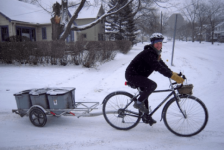
Build a Bicycle Cargo Trailer
10/23/2012 5:08:07 PM
By Doug Costlow
Tags: bicycle cargo trailer

Have you ever wanted to take something extra with you when you ride your bike, but didn't know how you could get it on the bike and still be able to ride? I have, and believe me one of my favorite challenges about bike riding is figuring out how to strap anything from a tennis racket to a load of firewood to a bike. There is something about that moment when you wrap that bungee cord around your item just right, pull on it until your fingers hurt, and get it to hook on. You step back and think to yourself, "This is rigged but it just might stay on."
In my effort to carry more things with my bike, I decided to build a cargo trailer. It wasn't going to be a typical trailer, though. I wanted something that was heavy-duty, maybe something that could handle most household appliances. I got started just like with every other good homemade bicycle cargo trailer—with a pair of garbage-picked wheels and a set of tires that were given to me for free.
Here is a quick rundown of the main features of the cargo bike trailer:
•Large 28-by-41-inch deck
•Mounts to any bike rack with a quick-release ball joint
•1-inch square steel tube frame can accommodate up to 700-centimeter/29-inch wheels and tires
•100-millimeter dropout spacing to allow for most bicycle front wheels
•Space for toolbox with tools, straps, and bungee cords
•Adjustable pulling arm to allow mounting to any bike
My main motivation for building this DIY cargo bike came from many bike-move videos and blog posts on this topic. A bike move is just what it sounds like—moving to a new house using only bikes for transportation and hauling. This requires cargo bikes, bike trailers and the blank stares of people as you ride past with a massive load of stuff on your bike.
You're probably wondering, "How much can I really tow with a bike?" Well, the company Bikes At Work sells bicycle cargo trailers and has some great references on hauling large items by bike. Check out How Much Weight Can a Bicycle Carry? for a calculator on towing weight. It states that "Most people can comfortably pull 300 pounds (137 kilograms) with a typical mountain bike and cargo trailer." I have not purchased anything from this company but, from the info they give and the pictures of their trailers in action, I believe they sell a good product, although a little pricey.
So, now that you see the potential behind a simple DIY cargo bike trailer, let's build one!
NOTE: To use this bicycle cargo trailer you must have a bike rack.
Step 1: Assemble the Tools, Materials and Plans
Here is a list of the tools and materials you will need to build this bicycle cargo trailer.
Tools
A. 4.5-inch angle grinder with cutoff, grinding and sanding discs
B. Drill press with vice or c-clamp (not absolutely needed but makes drilling steel much easier)
C. Drill bits, sizes 1/4-inch, 5/16-inch and 3/8-inch
D. 3/8-inch No. 16 tap
E. Center punch
F. Hammer
G. Welder (I am currently using the 90-amp flux core welder)
H. Welding gloves and helmet
I. Tape measure
J. Permanent marker
Materials
A. 1-inch square tube steel (I got most of the steel for this trailer from an old BBQ grill and a bench-press stand)
B. 2-by-3/16-inch steel flat bar, 1 foot long
C. 1-by-3/16-inch steel flat bar, 1 foot long
D. 3/8-inch No. 24 threaded bolt rod, 1 1/2-inch long (fine thread size; could come from an old bike axle or you can just cut off the head of a right-sized bolt)
E. Two 3/8-inch No. 24 nuts (might also be able to use bike axle nuts)
F. Four 1/4-inch No. 20 2-inch long bolts with nuts and washers
G. Two 3/8-inch No. 16 1.5" long bolts with nuts and washers
H. Four 5/16-inch No. 18 eye bolts with nuts and washers
I. 28-by-41-inch piece of 3/4-inch MDF (for the deck of the trailer; you can use whatever material you want)
J. Quick disconnect ball linkage (McMaster part No. 6058K34)
K. Two bike wheels and tires (I used 20-inch wheels, but the frame design allows for larger 700-centimeter wheels)
Aside from the quick disconnect linkage, all items can be found at a local hardware store or picked from old bike parts. If you're going to purchase the steel, I would highly recommend finding a local steel supplier by searching the Yellow Pages. If that's not an option for you, I would recommend http://www.SpeedyMetals.com for fair prices and reasonable shipping.
If you're lacking some of the tools I mentioned, borrow them from an uncle, check out yard sales or search http://www.CraigsList.org. These tools are pretty common and should be easy to find at low cost. For the welder, a MIG or wire welder is best for this project. It is completely doable with a stick or even a TIG welder, so just use what you have. If you have never welded before, the 90-amp flux core welder I'm using is enough to learn with, and at roughly $100 it's by far the best bang for your buck.
Open my Trailer Drawings PDF to view detailed drawings of the frame and the pulling arm, both of which are explained in the next few steps.
Step 2: Make the Dropouts

The dropouts are easy to make from 2-by-3/16-inch flat bar. First, put a cutoff wheel on your angle grinder. Cutoff wheels for this type of grinder are roughly 1/8-inch thick. If the wheel you have is thicker than that, it's not a cutoff wheel but a grinding wheel. Now put on your safety glasses; this is a must because your grinder will be throwing sparks everywhere. Mark off a 3-inch section of the bar and cut it off. I found that a good practice for cutting with a grinder like this is to first make a shallow cut right along your line. This will act as a guide when you make the rest of the cut. Repeat three more times to get four 3-inch long pieces.
Now get out the ruler and permanent marker and mark a point in the middle of each piece 3/4-inch from the end. Then grab your hammer and center punch, put the punch on your mark and hit it with the hammer. Don't miss! Next put one of the pieces in your vice and center up the center-punch mark with the drill bit in your drill press. Clamp everything down tight and put a dab of motor oil on the drill bit. This is not the ideal coolant method, but it will keep your bit from going dull. Set your drill press to the lowest speed possible, less than 500 rpm if you can. Then drill the hole and repeat for the next three parts.
Next, make a few marks from the edges of each hole to the edge of the part. Then get out your grinder and cut from the hole to the edge of the plate. When you're finished with all four dropouts, you'll be a cutoff wheel master and ready to tackle the rest of the project.
Step 3: Weld the Frame

The frame is built from 1-by-1-inch square steel tubing. I recycled this material from an old BBQ grill and a bench press stand. The tubing already had the nice right-angle curved bends so all I had to do was cut and weld it together. The main box of the frame came from the legs of the bench press, which were butt-welded together. The two outer parts of the frame came from the BBQ grill and were also butt-welded together. The interior parts of the frame were straight sections of tubing and were welded in after finishing the perimeter of the frame.
If you don't have the luxury of steel tubing lying around, you can buy tubing from a local steel supplier. You don't need bends at the corners but they do make the trailer look nice. If you have straight tubing, you could bend it yourself with a Woodward Fab Pipe/Tube Bender.
Step 4: Fabricate the Pulling Arm

The pulling arm attaches the trailer to your bicycle rack. The arm is made from 1-by-1-inch steel tubing and 1-by-3/16-inch steel flat bar. The pulling arm attaches to the upright tube on the frame with two pinch bolts. The top pinch bolt goes through the two clamping plates with the 3/8-inch holes and around the upright tube. This clamps firming on to the upright tube. The bottom pinch bolt tightens against the upright tube and uses the tapped hole. This keeps the arm from twisting on the upright tube. I chose to attach the pulling arm in this way because I wanted to be able to adjust the height of the arm in order to keep the trailer platform level. By moving the arm up and down, I can adjust for different bike rack heights, so the trailer can always be level on any bike it's attached to.
Step 5: Build the Trailer Platform
I choose to use medium-density fiberboard (MDF) for the platform of the trailer, but realize now that it might not have been the best choice. A treated plywood may be better because it can get wet and not fall apart like MDF. You can use whatever sheet material you have, but something as rigid as 3/4-inch MDF or plywood is preferable. Making this platform is pretty simple. The dimensions are 28-by-41 inches. I cut a piece using a circular saw, then I clamped it to the trailer and marked the radius of the corners and cut those out with a jigsaw. I clamped it again to the frame and marked the locations of the mounting holes in the frame. I drilled the holes with a 1/4-inch bit, for the 1/4-inch bolts I called for in the parts list. I also wanted to make sure the platform was not obstructed by the heads of the bolts, so I marked out a section around the holes and used my router to cut out a pocket.
Step 6: Prepare Your Bike Rack

You need a rack to mount and pull this bicycle cargo trailer. The frame design and pulling arm are centered around this type of setup. The trailer is connected to the bike rack with a quick disconnect ball linkage (McMaster part No. 6058K34). This linkage has a ball much like the towing hitch used on cars and trucks, but much smaller. The other part of the linkage that attaches to the trailer has a spring release so it is very easy to detach the trailer from the bike, but still securely captures the ball when pulling. To mount this to your bike rack, just drill a 3/8-inch hole in the platform. I suggest putting the hole in the center of the rack and forward of the rear axle. Most racks have a crossbar underneath the platform—don't drill though this, but put your hole near it for added stiffness. Also, don't drill through your tire! It's probably best to either remove the rack or your rear wheel from your bike when drilling. Mount the ball to the bike rack with a 3/8-inch No. 24 nut, and you're done.
Step 7: Accessorize
I made the frame a little longer in the front so I would have a spot to mount a toolbox secured with a bungee cord. Here are the items I carry in the toolbox:
A. 1/2-inch and 9/16-inch wrenches (for the bolts and nuts used on the trailer)
B. Bungee cords of various lengths and styles
C. Set of ratchet straps (for holding the load)
D. Roll of tape (always seems to help when securing the load)
Step 8: Start Towing
View attachment 1
Just hook the trailer to your bike and load it up. I have found this bicycle cargo trailer to be very maneuverable. I can ride in slow tight circles with the trailer attached and it just spins in place behind me. It would be very difficult to jackknife with this cargo bike trailer, but I'm not going to say it can't be done.
The first thing I hauled with the trailer was a BBQ grill. I rode 7 miles on fairly flat roads with moderate traffic and only had one issue: The garbage-picked wheels really needed to be trued because there was a harsh vibration around 12 mph. This was an easy fix.
If you've been thinking about building a bicycle cargo trailer, stop thinking and just do it. You will be surprised at how useful your bike will become. If you are moving, you should definitely consider a bike move. The best part about a cargo bike trailer is the looks you get from people as you ride by. Everyone assumes that pulling things with a bike is impossible, or at least impractical, but their minds will be blown when you cruise past. Have fun, ride safe and wear a helmet.


